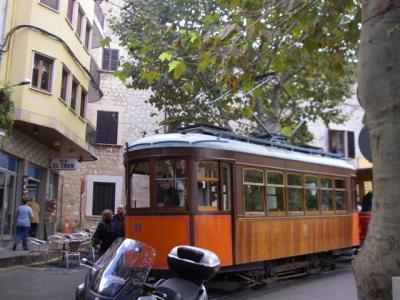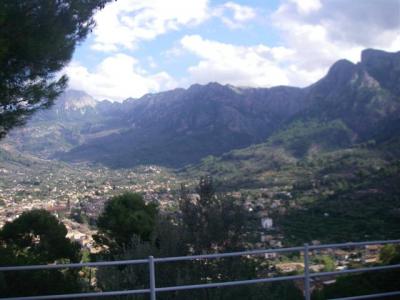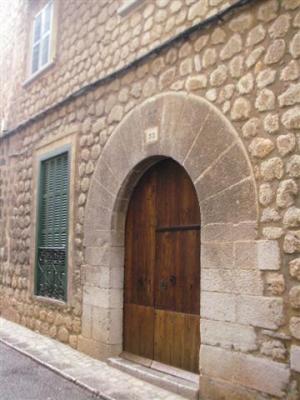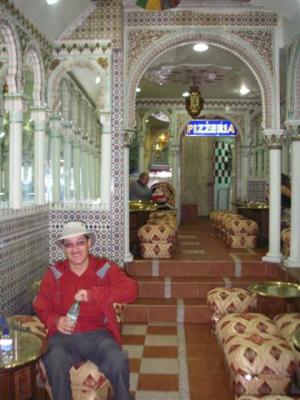Last night the marina wasn’t nearly as rocky as it has been. Yes, we were moving, but we felt like we were in an anchorage, not at sea. The lines weren’t making the horrific noises. So, we actually slept soundly and woke up feeling rested. We had planned to take the old train to the other side of the island today if the weather was nice. We were so happy to see that the sky was blue and the wind was relatively light. Awesome! We were taking a train ride.
We took the downtown bus to the train station, which is across the street from the main town square, and got tickets. We had about 45 minutes to kill, so we found a restaurant that serves breakfast nearby. We now consider breakfast a high luxury, and are always excited to find it. Actually, in Mallorca we have seen quite a few places advertise breakfast.
The train takes you from Palma due north to a town called Soller, which is about halfway along the northwest coast of the island. The line started in 1912, and the brochure gives the impression they are still using the same trains as back then. They are electric.

We noticed that most of the people getting on the train were local families with small kids. Lonely Planet had said it was a popular day trip for the locals, like San Diegans going to Julian. The ride up was an hour long. The outskirts of Palma a mix of farm land and industrial, and farther away it became all farms. We saw lots of sheep, as well as a few horses and goats. The farms are primarily olive groves and citrus fruit orchards. The olive trees were green and vibrant, the citrus trees barren. The grass was green and the flowers in bloom. It is pretty.
Almost halfway we came to the Sierra de Tramuntana mountains. The landscape changed to dramatic mountains dotted with small towns. We went through a series of tunnels, and in between tunnels took in the views of the peaks above and the valleys below. Not far from Soller, the train stopped at a scenic viewpoint overlooking a small town nestled in a valley between some of the mountains. Everyone got out and took photos, then the train continued on.

Finally we came to Soller, which is another cute valley town surrounded by mountains, not very different from the one we were snapping photos of earlier. The train dropped us off in the heart of town, which is 2 kilometers from the port. You can take a tram to the port. Most everyone on our train piled onto the tram. We decided to explore town first.
It started to rain almost as soon as we started to walk. By the time we made it the several blocks south to our destination, an ice cream factory, it was pouring. Eric was gravely disappointed that it turned out to be a little ice cream store where they claim to make the ice cream on the premises. He was hoping that we’d get to tour the factory, watch ice cream being made, and sample all the flavors. We got some ice cream and waited for the rain to stop.
When it did finally stop, we started walking around town some more. The rain continued intermittently, with many hard showers that lasted only a few minutes each. We frequently had to duck into shops and restaurants for cover. Despite the numerous stops, we managed to see a lot of the town. The community is centered around a typical European medieval village. The town square has a big gothic church and a really cool looking Gothic town hall building, pictured below. The rest of the square is surrounded by restaurants and cafes.

The main street is a series of shops selling a wide variety of touristy stuff, particularly local made crafts and foods. In addition to ice cream, olives and fruit, they also produce olive oil, pate and sausages, jams, citrus fruit liqueurs, shoes and more. Many of the structures have rock walls, not stone blocks, but uneven rocks. The streets are narrow and some are still cobblestone. Beyond the main drag, many streets are solely residential, and other streets with commercial activity are geared more towards the locals. Beyond the town center, there is the same eclectic mix of new and old that characterizes downtown Palma, except being as it is a small town, most of the buildings are small two and three story versus the mid to high rises in Palma. We like the big variety of styles and design in the outlying neighborhood. This is a typical residential building in the historic district.

One of the stops we made to avoid the rain was one of the local art galleries. It is in the same building as the train station, has two permanent exhibits, and surprisingly, admission is free. The first features pieces by the Mallorcan artist Joan Miro. Miro was a modern artist who seems to be revered in Mallorca. We walked through the exhibit. His art is interesting, but we have to admit that we don’t have a huge appreciation for modern art.
The second gallery features a collection of ceramics Picasso made. We have both taken art classes in school, particularly Christi, and neither of us knew Picasso did ceramic work. We enjoyed the Picasso gallery more than most modern art exhibits because of the novelty of the medium. Something that we thought was hilarious is that the gallery has a few cardboard cutouts on display. The cardboard pieces are intermixed with the real pieces and are displayed with the same pomp and circumstance, including special stands and lighting. Granted, the cardboard pieces are high quality and you can’t tell they aren’t the real deal until you get really close to them. And there are only a few, most of the display is real stuff. There are vases, plates, cups, trivets”¦ the usual things made from ceramic. This is a pitcher.

We couldn’t duck into any other galleries or museums because they were all closed for the holiday. After about three hours, we were eager to get out of the rain. We had seen most of the town and decided to skip the port and head back to Palma. We figured we have already seen a seaport or two before.
When we got back we were surprised to see it was still sunny and clear in Palma, just like when we left. We grabbed a late lunch at a nearby pizzeria with a very cool Arabic interior.

We were both in a great mood. The nice outing and shining sun had completely cleared away yesterday’s depression. When we got back to Kosmos, Eric tested out his shaft packing tool to see if it would work. While still broken, he could get it to work enough to finish the shaft packing job. Yes! That means we have a second major project checked off the “to do” list (first project was stabilizer repair).

Onya Eric